Goldstone Deep Space Communications Complex
|
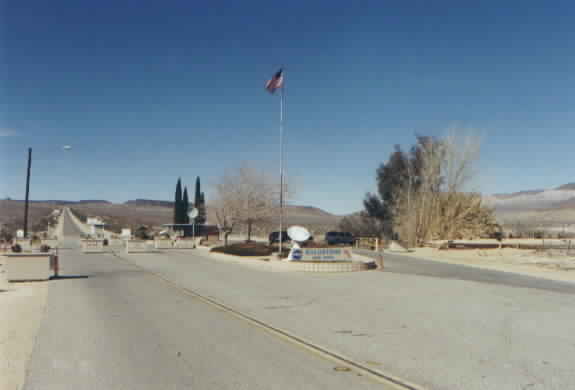
|
|
Goldstone is one of three Nasa/Jet Propulsion Labs installations for
tracking and communicating with spacecraft. Although it can be used to
help out with comm with the shuttle or other low earth orbit craft, the
network's primary purpose is to keep tabs on deep space craft, like
Pioneer, Voyager, and the like: most recently its famous clients include
the Mars Exploration Rovers Spirit and Opportunity. The network can also
be used for limited radio astronomy.
|
|
There are three installations spaced roughly 120 degrees apart in
longitude, so that at least one can see a given part of the sky
(limited to some degree around the celestial equator) at any time. Two
are in the northern hemisphere (Goldstone and Madrid, Spain) and one is
south of the equator (Canberra, Australia). This gives limited coverage
of the entire sky, to cover those craft that leave the ecliptic plane.
|

|
|
All of the sites have at least four antennas: a 34 meter (111 feet)
high-efficiency dish, a 34 meter Beam Waveguide dish, a 26 meter (85
feet) general purpose dish, and the "coup de gras", a 70
meter (230 feet) monster dish. Goldstone also serves as the development
center, if you will, so it is equipped with more: it has three of the 34
meter Beam Waveguide antennas, for example, one of which is pictured
above.
|

|
|
In fact, there are dishes all over the place! In the shadow of the 34
meter dish above are a smaller (9 or 11 meters, I think) and what looks
to be a TVRO dish.
|
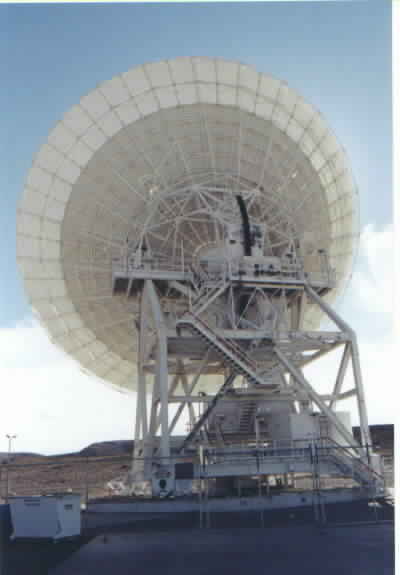
|
|
A view of the back of the 34 meter dish. It was in use when we were
there: there was a flashing red caution light indicating that a
transmitter was active. These antennas are definitely not "receive
only", they are also used to send commands to the spacecraft.
|
|
This is one of the waveguide antennas, so named because the transceiving
antenna is not located at the focal point of the dish. Instead a
tube (waveguide) is used to direct the received signals down to, and the
transmitted signal up from the antennas located in an equipment room
below the dish, and out of the weather. This also allows for transceiver
maintenance without taking the dish out of service.
|
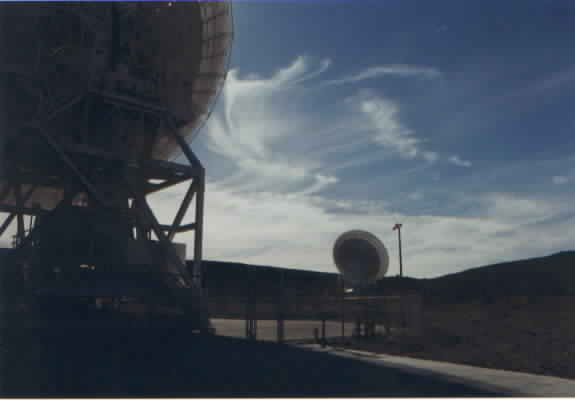
|
|
Another dish (I forget whether it was another 34 meter or a smaller one)
and some light clouds.
|
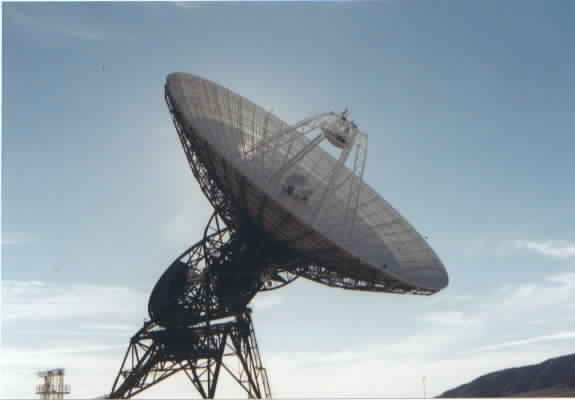
|
|
Wish they did this when I was in school! This 34 meter dish was decommissioned
some time ago, and was going to be dismantled when someone came up with
a bright idea. So, it is now part of the Goldstone Apple Valley Radio
Telescope, an educational joint venture of Nasa, JPL, and the Lewis
Center for Educational Research. If you are a teacher and your school is
not part of this, check it out at their
web site! (They assured us the transmitters were disabled before
they turned the installation over to the kids...)
|
|
This dish, located right at the visitor's center, is also interesting in
the fact it has an equatorial type mount, as opposed to the alt-azimuth
mount I expected all of the dishes to have. Originally known as DSS-12,
the antenna was used to track robotic planetary missions. I suppose in
the "good old days" an equatorial mount, which will normally
only have to be moved on one axis to keep up with an object in the sky,
was easier to control with less computer power.
|

|
|
Someone made the remark that the other two complexes at Canberra and
Madrid were nice and compact. Goldstone is spread out all over the
place, in part because it was the first, and they were not sure if the
antennas would interfere with each other. Located on the grounds of Fort
Irwin, near Barstow, CA, the complex is in a small valley, with hills to
block potentially interfering signals. Above is shot from the car showing
the desert, the sign proclaiming Mars Station, and our first glimpse of
"the big one"! We were also told that there is one dish that
is not on the tour: Fort Irwin is an active training center, and you
have to traverse a live fire area to get to it. That's OK, there are
plenty of others to see!
|
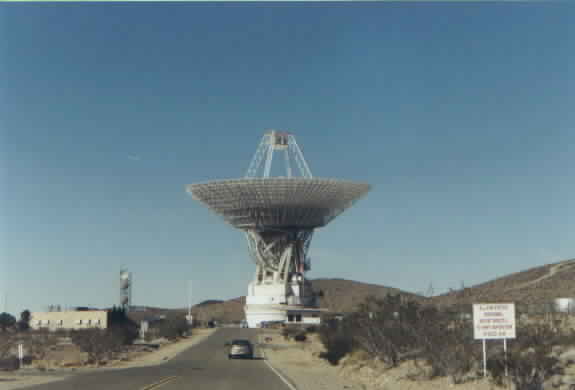
|
|
Another view as we get closer. These pictures just don't convey how big
this thing is! The dish is in its "parked" position here, pointing
straight up. In this position it offers the least wind resistance, and
must be returned to this position whenever the winds are approaching 45
MPH. We were there on January 15, 2004, the day they rolled MER
"Spirit" off of her lander, so this guy was going to get a
workout that night after Mars rose.
|
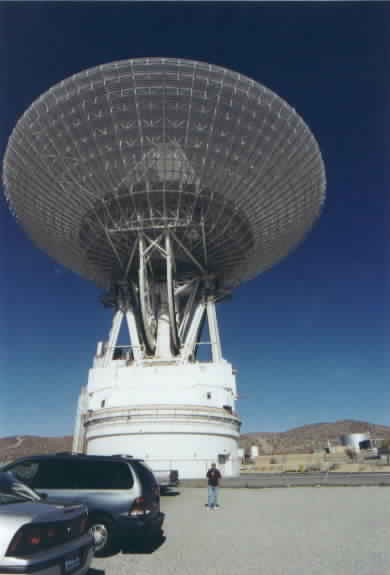
|
|
At the base of the antenna, we had to resort to the 18mm lens to get the
whole dish, so the extreme wide angle distorts the image somewhat, and
you still don't get a good feel for how big this thing is! Note the door
directly behind Pat to gauge how big the base is. The ring about about
halfway up the base cylinder is how the antenna above, riding on a
paper-thin sheet of oil, is turned in azimuth. If I understood
correctly, the antenna can only be turned 45 degrees in one direction,
before it must be "ratcheted" back some amount, to keep the
oil �properly distributed.
|
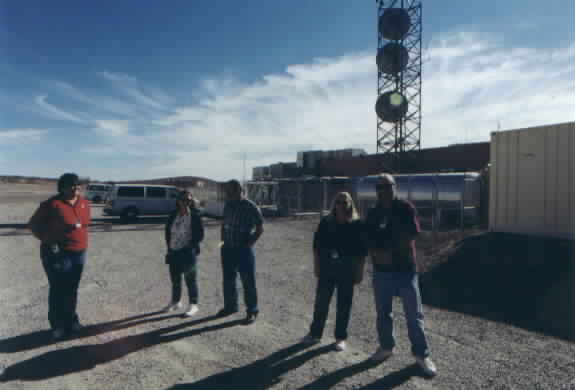
|
|
A group shot: from the right, the old hippie (me), Marie Massey, our
JPL escort, another couple whose names I didn't get, and Karla Warner,
another JPL escort. Jan took the picture. Behind us is the signal
processing facility, which unfortunately was off limits to the public at
this time, due to the sensitivity of current events (not 9/11 this time,
but the fact that the MER missions were in full swing). There is also a
mini-visitor's center in the base of the big dish which we did not get
to see, but check out this
link. I think that tank is for
some cryogenic cooling for some of the low-noise amps. Also visible was
a bank of a half-dozen or so mufflers for local diesel generators:
whenever a "level one" event is occurring (data from Mars, for
example) the participating antenna and receiver complex go on local
power, so that unexpected interruptions don't occur (I suppose the
commercial power source is kept in standby as a backup... an interesting
turn of events!). Notice the microwave dishes: these are obsolete now (maybe
kept for backup?), with all data moving over a Fiber Optic network. We
did notice a few dipoles hanging off of the tower, and one of the
trucks in the parking lot definitely belonged to a ham!
|
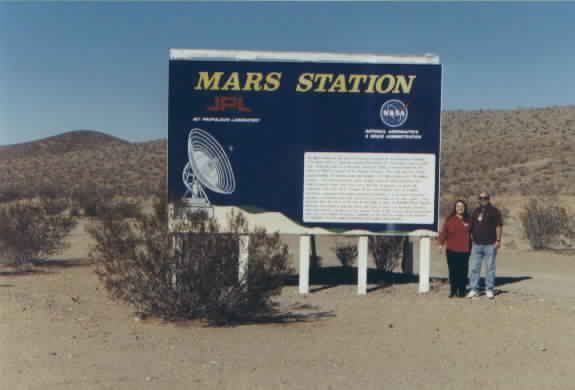
|
|
Marie took this shot of us on the way out. Don't do
what we did: we were staying in Barstow the night before, and we called
about 8:15 AM to inquire about the possibility of a tour. We had to
drive like the proverbial bat to get there for the 9:00 AM start (in
fact we were a little late, but Marie was kind enough to give us a few
minutes leeway). You have to go through the gate at Fort Irwin (have
valid ID and car registration or rental contract!) and the folks at
Goldstone have to let them know that you are coming. Then Marie or
another escort will meet you at the gate to Goldstone. Email Marie at
"MMassey(at)jgld(dot)gdscc(dot)nasa(dot)gov" to set things up.
(Thank the spambots for the address format; hopefully you know what to
do!)
|
|
Some interesting links:
|
|
Canberra
|
|
The DSN Web Site
|
|
The TDRSS Network
|





















